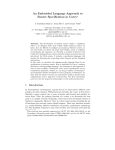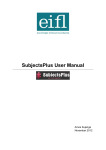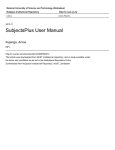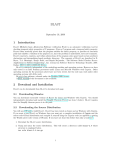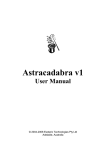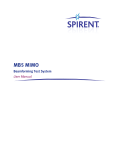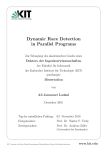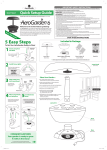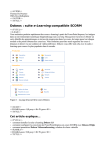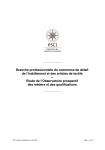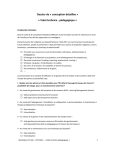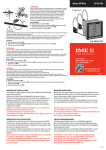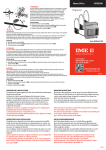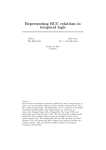Download Annotation-based property checking for systems software
Transcript
Annotation-based property checking for systems software Thomas Ball Microsoft Research [email protected] Brian Hackett Stanford University [email protected] Abstract Specifying procedure contracts for buffer overruns in systems code has been effective in detecting and fixing thousands of vulnerabilities in Windows. However, providing annotations for checking more system-specific properties can be challenging for systems code, typically written in C, due to the presence of objects in the heap and pointer arithmetic. In this work, we present an annotationbased property checker for such programs. Our checker retains precision, scalability, automation, and high coverage, in spite of the expressiveness of the supported annotations. We demonstrate the feasibility of our approach by applying it to check properties related to the synchronization protocol on a core Microsoft Windows component with more than 300,000 lines of code and 1500 procedures. The tool found 45 serious bugs in the component with a modest annotation effort. Most of these bugs have since been fixed by the developers of the module. 1 Introduction Developing and maintaining systems software such as operating systems kernel and device drivers is a challenging task. They consist of modules often exceeding several hundred thousand to millions of lines of code written in lowlevel languages such as C and C++. In many cases, these modules evolve over several decades and the original architects or developers may have long ago departed. Such software may become fragile through the accumulation of new features, performance tuning and bug fixes, often added in an ad-hoc manner. Given the astronomical number of paths in any real program, testing can only cover a relatively very small fraction of the paths in a module. Bugs found in the field often occur in these rarely exercised paths. Static compile-time tools have the potential to discover bugs early in the development cycle with high coverage, and offer an attractive complement to testing. Microsoft’s Standard Annotation Language (SAL) is a meta-level language for assisting static analysis tools to find bugs primarily related to buffer-overruns in C or C++ code [16]. It provides Shuvendu K. Lahiri, Shaz Qadeer Microsoft Research {shuvendu,qadeer}@microsoft.com a set of annotations to describe how a function uses its parameters — the assumptions it makes about them, and the guarantees it provides on exit. Modular checking of these contracts, where each procedure is analyzed only with the contracts of other procedures, provides a scalable method for applying static analysis to millions of lines of code. SAL annotations and static checking tools based on these annotations (such as ESPX [16]) have had a significant impact on the development process inside Microsoft. A substantial fraction of Windows source has been annotated with various SAL annotations and thousands of potential security vulnerabilities have been discovered and fixed. The annotations also serve as valuable documentation for the procedures, providing quick feedback of any breaking changes on the developer’s desktop and preventing many severe bugs. However, SAL-based checkers are custom built for a class of properties (e.g. buffer overrun checking in ESPX) and use ad-hoc techniques that sacrifice soundness for fewer false alarms. As a result, it is difficult to extend the checkers to support a large class of user-defined properties. Examples of such properties can range from generic properties such as “lock l is acquired and released alternately” and “field f in object x is protected by the lock l” to more system-specific properties such as the absence of teardown races1 , which requires knowledge of the synchronization protocol of the system. The ability to check such properties enables early diagnosis of bugs that are notoriously hard to detect and reproduce. In this work, we present a general-purpose annotationbased property checker for systems software written in C, implemented in the H AVOC tool [6]. H AVOC provides an expressive annotation language to specify user-defined properties, and most intermediate assertions required to prove such properties. In spite of its expressiveness, the checker retains precision, scalability, automation and high coverage by a combination of the following: 1. An accurate memory model for C programs accounting for low-level operations such as pointer arithmetic 1 Deletion or freeing of an object being accessed by another thread. and addresses of internal fields. 2. Precise reasoning about call-free and loop-free fragments of code inside a procedure using the accurate memory model and the B OOGIE [5] verifier. 3. Scalable checking of constraints using state-of-the-art Satisfiability Modulo Theories (SMT) solver Z3 [10]. 4. An annotation assistant for interprocedural inference of simple contracts based on a variant of the Houdini algorithm [14]. 5. Prudent use of explicit assumptions about type-safety and type invariants about data structure shapes. These assumptions are required to verify high-level properties with low false alarm, but verifying them might require significant annotation overhead. We demonstrate the feasibility of the approach by applying it on a core component C OMP of the Windows kernel — the name of the module and the code fragments have been modified for proprietary reasons. The code base has more than 300,000 lines of C code and has evolved over two decades. The module has over 1500 procedures, with some of the procedures being a few thousand lines long — a result of the various feature additions over successive versions. For this component, we specified and checked properties related to the synchronization protocol on its main heap allocated data structures. The properties include checking for resource leaks, improper lock usage, data races and teardown races. The highlights of the effort were: 1. H AVOC found 45 bugs in the C OMP module that were confirmed by the developers and many of them have been fixed at the time of writing. Most of these bugs appear along error recovery paths indicating the mature and well-tested nature of the code and signifying the ability of H AVOC to detect subtle corner cases. 2. The checking required modest annotation effort of about 250 annotations for specifying the properties and operating system model, 600 annotations for procedure contracts. An annotation assistant generated around 3000 simple annotations, a bulk of the required annotation effort, to relieve the need for annotating such a large code base. This corresponds to roughly one manual annotation per 500 lines of code, or one per 2.5 procedures. 3. The tool currently reports 125 warnings, including the 45 confirmed bugs, when the checker runs on the annotated code base. The extra warnings can be minimized at the cost of more annotations. The rest of the paper is organized as follows: In Section 2, we illustrate our approach with a simplified problem of data race checking from C OMP; we describe our annotations and the checker in Section 3 and the annotation assistant in Section 4. We describe the details of our case study on C OMP in Section 5, discuss related work in Section 6, and finally conclude in Section 7. 2 Illustrative example In this section, we illustrate the challenges involved in checking properties of low-level systems software, with an example of data-race checking on the main heap-allocated data structures in C OMP. These data structures are fairly representative of low-level systems software. Our example demonstrates that modular verification of data-race freedom on C OMP code requires (i) annotations involving pointer arithmetic, aliasing, and conditional specifications, (ii) loop invariants to deal with unbounded sources of data (e.g., lists), and (iii) explicitly assumed type invariants for trading off soundness for scalability. We first describe high-level details of the data structure and the synchronization protocol, some procedures manipulating these structures, and finally the annotations to check the absence of data races. 2.1 Example Figure 1 describes a few types for the heap-allocated data structures in C OMP. The type LIST ENTRY is the generic type for (circular) doubly-linked lists in most of Windows source code. It contains two fields Flink and Blink to obtain the forward and backward successors of a LIST ENTRY node respectively in a linked list. An object of type NODEA contains a list of children objects of type NODEB using the field NodeBQueue. Figure 3 describes the shape of the children list for any NODEA object. Each child NODEB node also maintains a pointers to its parent NODEA object with the ParentA field. The macro CONTAINING RECORD (defined in Figure 1) takes a pointer addr to an internal field field of a structure of type type and returns the pointer to the enclosing structure by performing pointer arithmetic. The helper macros ENCL NODEA and ENCL NODEB uses the CONTAINING RECORD macro to obtain pointers to enclosing NODEA and NODEB structures respectively, given a pointer to their respective LIST ENTRY fields. The CONTAINING RECORD macro is frequently used in systems software and is a primary source of pointer arithmetic. Since these objects can be accessed from multiple threads, one needs a synchronization mechanism to ensure the absence of data-races on the fields of these objects. Each NODEA structure maintains a field Resource, which typedef struct _LIST_ENTRY{ struct _LIST_ENTRY *Flink, *Blink; } LIST_ENTRY, *PLIST_ENTRY; typedef struct _NODEA{ PERESOURCE Resource; LIST_ENTRY NodeBQueue; ... } NODEA, *PNODEA; typedef struct _NODEB{ PNODEA ParentA; ULONG State; LIST_ENTRY NodeALinks; ... } NODEB, *PNODEB; #define __resrA_held(x)\ __resource(‘‘NODEA_RESOURCE’’,x) > 0 VOID CompClearChildState(PNODEA NodeA, ULONG StateMask) { CompAcquireNodeAExcl(NodeA); PNODEB NodeB; CompFindChildState(NodeA, StateMask, &NodeB); #define CONTAINING_RECORD(addr, type, field)\ ((type *)((PCHAR)(addr) -\ (PCHAR)(&((type *)0)->field))) //helper macros #define ENCL_NODEA(x)\ CONTAINING_RECORD(x, NODEA, NodeBQueue) #define ENCL_NODEB(x)\ CONTAINING_RECORD(x, NODEB, NodeALinks) Figure 1. Data structures and macros used in the example. is a pointer to a ERESOURCE structure that implements a reader-writer lock. The lock not only protects accesses to the fields in the NODEA structure but additionally also protects the NodeALinks, ParentA and State fields in any of its NODEB children. Figure 2 describes three procedures that manipulate the NODEA and NODEB objects. For this example, we indicate the lines containing an annotation using an empty comment “/**/” at the start of the line. The procedure CompClearChildState takes a NODEA object NodeA and clears a mask StateMask from the State field of any NODEB child that matches this mask. It uses the procedure CompFindChildState in a loop to find all the children that match the StateMask and then calls CompClearState on the child to actually clear the mask. The procedure CompFindChildState iterates over the children for a NODEA object and returns either the first child that matches the mask, or NULL if no such child exists. To encode the data race freedom property on the fields of NODEA and NODEB objects, we introduce assertions that each access (read or write) to a field is guarded by the Resource lock in the appropriate NODEA object. The three procedures clearly satisfy data race freedom since the lock on the NODEA object is acquired by a call to CompAcquireNodeAExcl inside CompClearChildState before any of the operations. /**/__loop_invariant(NodeB != NULL ==> /**/ NodeB->ParentA == NodeA) while (NodeB != NULL) { CompClearState(NodeB, StateMask); CompFindChildState(NodeA, StateMask, &NodeB); } CompReleaseNodeA(NodeA); } /**/__requires(__resrA_held(NodeA)) /**/__ensures (*PNodeB != NULL ==> /**/ (*PNodeB)->ParentA == NodeA) VOID CompFindChildState(PNODEA NodeA, ULONG StateMask, PNODEB* PNodeB) { PLIST_ENTRY Entry = NodeA->NodeBQueue.Flink; /**/__loop_invariant( /**/ Entry != &NodeA->NodeBQueue ==> /**/ ENCL_NODEB(Entry)->ParentA == NodeA /**/ ) while (Entry != &NodeA->NodeBQueue) { PNODEB NodeB = ENCL_NODEB(Entry); if (NodeB->State & StateMask != 0) { *PNodeB = NodeB; return; } Entry = Entry->FLink; } *PNodeB = NULL; return; } /**/__requires(__resrA_held(NodeB->ParentA)) VOID CompClearState(PNODEB NodeB, ULONG StateMask) { NodeB->State &= ˜StateMask; } Figure 2. Procedures and annotations for data race freedom. #define FIRST_CHILD(x) #define NEXT_NODE(x) R N o e d s e u B F B N o Q l i l O r D u n i c e u __type_invariant(PNODEA x){ ENCL_NODEA(FIRST_CHILD(x)) != x ==> ENCL_NODEB(FIRST_CHILD(x))->ParentA == x ) e k n k E A P a r S N e n t o d F N a e B t t n i O a r S L i l P e A l A i n k s N d B E B N a e F k D n t o k n e t t n i O a r S L i l P e A l A i n k s N o D B N i n i n k s k n O __type_invariant(PNODEB y){ NEXT_NODE(y) != &(y->ParentA->NodeBQueue) ==> y->ParentA == ENCL_NODEB(NEXT_NODE(y))->ParentA ) A e L i l t t A l B E a e F k n t d k n e k D E B Figure 3. The list of NODEB children of a NODEA. 2.2 x->NodeBQueue.Flink x->NodeALinks.Flink e Annotations Now, let us look at the annotations required by H AVOC to verify the absence of the data race in the program. The procedure CompClearState has a preconrequires that holds dition (a condition inside at the entry to a procedure) that the Resource field of the NodeB->ParentA is held at entry; this ensures that the access to NodeB->State is resource property protected. The annotation (‘‘NODEA RESOURCE’’, x), which the macro resrA held(x) expands to, returns the value of a ghost field called ‘‘NODEA RESOURCE’’ inside x. The integer valued ghost field ‘‘NODEA RESOURCE’’ tracks the state of the Resource lock in a NODEA object — a positive value denotes that the Resource is acquired. For brevity, we skip the annotations for CompAcquireNodeAExcl and CompReleaseNodeA, which increment and decrement the value of the ghost field, respectively. The procedure CompFindChildState has a similar precondition on the NodeA parameter. The procedure also has a postcondition (a condition inside an ensures that holds at exit) that captures child-parent relationship between the out parameter PNodeB and NodeA. Let us inspect the annotations on CompClearChildState. We need a loop invariant (a condition inside loop invariant that holds every time control reaches the loop head) to ensure the precondition of CompClearState inside the loop. The postcondition of CompFindChildState ensures that the loop invariant holds at the entry of the loop and also preserved by any iteration of the loop. Finally, consider the loop invariant in procedure CompFindChildState: the loop invariant is required Figure 4. Type invariants for NODEA and NODEB types. for both proving the postcondition of the procedure, as well as to prove the absence of a data race on NodeB->State inside the loop. This loop invariant does not follow directly from the annotations on the procedure and the loop body. To prove this loop invariant, we specify two type invariants for NODEA and NODEB objects using the type invariant annotation in Figure 4. The type invariant on any NODEA object x states that if the children list of x is non-empty then the parent field ParentA of the first child points back to x. The type invariant for any NODEB object y states that if the next object in the list is not the head of the circular list, then the next NODEB object in the list has the same parent as y. The two type invariants capture important shape information of the data structures and together imply that all the NODEB objects in the children list of NodeA point to NodeA. Proving type invariants require reasoning with quantifiers, which is undecidable, and may require significant annotation overhead. Hence, these type invariants are currently assumed (but not asserted) at various control locations in the program. The type invariants have to be written down only once for each type and therefore the complexity of writing these complex annotations is justified when checking a large code base such as C OMP. Moreover, they can later be verified at the cost of more human effort. 3 Annotations and checker In this section, we illustrate the features of the tool that enable us to specify and check system-specific properties of legacy code. 3.1 Expressive annotations Our annotations are similar in spirit to those found in ESC-JAVA [15] for JAVA programs, and SPEC# [5] for C# programs, but are designed for verifying systems programs written in C. We provide an overview of the subset of annotations that were used in this work. More details of the annotation language and advanced features are described in the HAVOC user manual available with the tool download2. Procedure contracts. Procedure annotations consists of preconditions, postconditions and modifies clauses. The requires annotation specifies a precondition that holds at the entry to a procedure. This assertion is assumed when analyzing the body of the procedure and checked at all callsites of the procedure. The ensures annotation specifies a postcondition that holds at exit from the procedure. The modifies annotation specifies a set of locations that are possibly modified by the procedure; it generates a postcondition that all other locations in the heap remain unchanged. The postconditions are checked when analyzing the body of the procedure, and assumed at all call-sites for the procedure. Loop invariants. The loop invariant annotation specifies an assertion that holds every time control reaches the head of the loop. The assertion is checked at entry to the loop, and should be preserved across an arbitrary iteration of the loop. Type invariants. Figure 4 illustrates type invariants for the NODEA and NODEB types, specified using a type invariant annotation. Type invariants specify assertions that hold for all objects of a given type. Such invariants typically hold at all control locations except a handful of procedures where an object is being initialized or being torn down, or may be broken locally inside a basic block (e.g. when an NODEB object is added as a child for NODEA). The user has the flexibility to choose the control locations where he or she expects the invariants to hold. Proving type invariants require quantifier reasoning. Since reasoning with quantifiers is undecidable and highly unpredictable in practice [18], we provide an option to allow the user to assume the type invariants when checking other high level properties. These assumptions can be proved, but may require expensive analysis and significant annotation overhead. Annotation expressions. A novel feature of our annotation language is that it allows most call-free and side-effect free C expressions in the assertions. The assertions can refer to user defined macros, thereby allowing complex assertions to be constructed from simpler ones. We allow referring to the return value of a procedure with the return keyword. The postconditions may also refer to the state at the entry to the procedure using the old keyword as follows: __ensures (__return == __old(*x) + 1) __modifies (x) int Foo (int *x) {*x = *x + 1; return *x;} Resources. In addition to the C program expressions, we allow the annotations to refer to ”ghost fields” (called 2 Available at http://research.microsoft.com/projects/havoc/ resources) of objects. Resources are auxiliary fields in data structures meant only for the purpose of specification and manipulated exclusively through annotations. We allow the user to use resource ("NODEA RESOURCE", NodeA) to refer to the value of the Resource field in NodeA. The annotation modifies resource (<NAME>, expr) specifies that the resource <NAME> is possibly modified at expr. Consider the following annotation on the procedure CompReleaseNodeA that releases the Resource field of a NODEA object: #define resrA(x) __resource(‘‘NODEA_RESOURCE’’, x) #define __releasesA(x)\ __requires (resrA(x) > 0)\ __ensures (resrA(x) == __old(resrA(x)) - 1)\ __modifies_resource(‘‘NODEA_RESOURCE’’, x) __releasesA(NodeA) void CompReleaseNodeA (NODEA NodeA); Annotations for exception handling. Microsoft C compiler supports Structured Exception Handling (SEH) to deal with flow of control due to software and hardware exceptions. In SEH, the program can use either try/ except blocks to implement an exception handler, or try/ finally blocks to deal with cleanup along both normal and exceptional paths. __try{ //guarded code } __except (expr) { //exception handler //code } H AVOC allows may throw __try{ //guarded code } __finally{ //termination code } (condition) annotations on procedures with the meaning that the procedure does not raise an exception if condition does not hold at entry to the procedure. This allows specifying may throw (TRUE) on one extreme to indicate that any call to the procedure may throw an exception, and may throw (FALSE) on the other extreme to indicate that the procedure never raises an exception. 3.2 Checker In this section, we provide a brief overview of the checker for verifying an annotated procedure. Interested readers can find more details in other works [6]. The main enabling techniques in the checker are: Accurate memory model for C. The first step in checking an annotated source is to define meaning to the annotations and the operations in the program. H AVOC provides a faithful operational semantics for C programs accounting for the low-level operations in systems code. HAVOC treats every C pointer expression (including addresses of stack allocated variables, heap locations, and values stored in variables and the heap) uniformly as integers. The heap is modeled as a mutable map or an array Mem mapping integers to integers. A structure corresponds to a sequence of pointers and each field corresponds to a compile-time offset within the structure. Pointer dereference *e corresponds to a lookup of Mem at the address e and an update *x = y is translated as an update to Mem at address x with value y. Annotation expressions are translated in a similar fashion. Given an annotated C program, H AVOC uses the memory model to translate the annotated source into a a B OO GIE PL [11] program, a simple intermediate language with precise operational semantics and support for annotations. The resulting program consists of scalars and maps, and all the complexities of C (pointer arithmetic, & operations, casts etc.) have been compiled away at this stage. Example of the translation can be found in earlier work [6]. Generating precise verification conditions. H AVOC uses the B OOGIE [5] verifier on the generated B OOGIE PL file to construct a logical formula called the verification condition (VC). Construction of the VC uses a variant of the weakest liberal precondition computation [4]. The VC is a formula whose unsatisfiability implies that the program does not go wrong by failing one of the assertions or the contracts. Moreover, H AVOC ensures that the VC generated for a loop-free and call-free program is unsatisfiable if and only if the program does not go wrong by failing any assertion or contract present in the code. This is in sharp contrast to most other static analysis tools that lose precision at merge points, or worse still at every instruction. Scalable checking using SMT solvers. The satisfiability of the VC is checked using a state-of-the-art Satisfiability Modulo Theories (SMT) solver Z3 [10]. SMT solvers are extensions of the Boolean Satisfiability (SAT) solvers that handle different logical theories such as equality with uninterpreted functions, arithmetic and arrays. These solvers leverage the advances in SAT solving with powerful implementation of theory specific algorithms. These tools can scale to large verification conditions by leveraging conflictdriven learning, smart backtracking and efficient theory reasoning. The modular analysis with efficient SMT solvers provides a scalable and relatively precise checker for realistic procedures up to a few thousand lines large. 4 Interprocedural inference H AVOC, like any other procedure-modular checker, requires contracts to analyze each procedure. However, it can be extremely cumbersome for the user to annotate every procedure for a large code base such as C OMP. Given a partially-annotated code base, where the user annotates the complex procedures, it is desirable to have an interprocedural analysis to infer simple annotations on the rest. In Figure 5, the procedure CompCreateChildWithAttribute creates a child of NodeA in CompCreateNodeB and then initializes different parts of the the child object and other data structures through several layers of deeply nested calls. Given the contract on CompCreateNodeB, we would like the tool to infer that NodeB->ParentA->Resource is held at entry to all the CompInitializeX procedures. void CompCreateChildWithAttribute( PNODEA NodeA, ATTRIBUTE attr,...){ PNODEB NodeB; CompAcquireNodeAExcl(NodeA); CompCreateNodeB(NodeA, &NodeB,..); CompInitialize1(NodeB, attr,...); ... } __ensures((*PNodeB)->ParentA == NodeA) void CompCreateNodeB( PNODEA NodeA, PNODEB *PNodeB,.. ); void CompInitialize1( PNODEB NodeB, ..){ <modify ParentA, State fields in NodeB > CompInitialize2(NodeB, ...); } void CompInitialize2(PNODEB NodeB,..){ <modify ParentA, State fields in NodeB> CompInitialize3(NodeB, ...); } Figure 5. Procedure calls chains In this section, we describe an annotation assistant based on the Houdini [14] algorithm in ESC-JAVA. The algorithm takes as input a partially annotated module along with a finite set of candidate contracts for each procedure in the module, and outputs a subset of the candidates that cannot be refuted along any interprocedural path. The algorithm performs a fix-point computation where at each step a candidate annotation that can be refuted is removed and the resultant set is reanalyzed. In the original implementation in ESC-JAVA, the Houdini algorithm was used with customized candidate annotations — namely for checking non-null assertions on parameters and return values. In our case, we provide directives to add candidate annotations to the procedures in the module by the following two mechanisms: 1. For assertions about global state of the program, we have an instrumentation directive to add a global contract to every non-entry procedure. This can be used to add an assertion that a particular global variable is non-null, or a lock in a global data structure is not held. 2. We also provide an type-based instrumentation of arguments and return values for non-entry procedures. For instance, we can direct H AVOC to add a precondition that x->ParentA->Resource is held, where x is a parameter to the procedure of type NODEB. Note that we don’t allow candidate contracts on the entry procedures, because they don’t have any callers. If the candidate contracts along with the user-defined contracts on such an entry procedure are inconsistent, then any contract would be provable vacuously. For all other procedures, such inconsistent contracts will be detected at the call-sites. In our implementation, we identify a procedure as non-entry (or internal) if at least one of its argument has a type that is internal to the module. 5 Application on C OMP In this section, we describe our experience with applying H AVOC on a core driver C OMP from the R Windowsoperating system. For the sake of security, we keep the component and the names of the procedures anonymous. The component has around 300,000 lines of code, excluding the sources for the kernel procedures. There are more than 1500 procedures present in the module. The code for the component has evolved over almost two decades, and each new generation inherits a lot of the code from the previous versions. Some of the procedures in the module have up to 4,000 lines of code, signifying the complexity and the legacy nature of the code base. C OMP also heavily employs the Microsoft Structured Exception Handling (SEH) mechanism for C/C++ to deal with flow of control due to exceptions, as discussed in Section 3.1. This drastically increases the number of control flow paths in the program, since in the worst case any procedure can raise an exception. We first provide a brief description of the main data structures involved in the synchronization protocols in C OMP. We will focus on four main types: NODE that is the root type which can contain multiple instances of NODEA, NODEB and NODEC types. Each NODE has an ERESOURCE field NodeResource and a mutex NodeMutex for synchronization. The ERESOURCE structure implements a reader-writer lock in Windows that can be recursively acquired. The NodeResource acts as a global lock for access to any NODEA, NODEB and NODEC objects within a given NODE (i.e. it is sufficient to acquire this lock to access any field in the NODEA, NODEB and NODEC objects). Each NODEA object has a list of NODEB children (as described in Section 2) and a list of NODEC children. Each NODEA has a ERESOURCE field Resource that protects most of its fields and the fields of its children NODEB and NODEC objects; each NODEA also has a mutex NodeAMutex that protects a set of other fields in each NODEA and its NODEB and NODEC children. Each NODEA also has an integer field ReferenceCount that signifies the number of threads that have a handle on a particular NODEA object — a positive value of ReferenceCount on an NODEA object indicates that some thread has a handle on the object and therefore can’t be freed. There is a global list ExclusiveNodeAList of all the NODEA objects for which the Resource has been acquired. A call to the procedure CompReleaseAllNodeAResources releases the Resource field of any NODEA on the ExclusiveNodeAList. We have checked the following properties whose violation can lead to serious bugs: 1. Ref-count usage. We checked that for every execution path, the increments and decrements of the ReferenceCount field of a NODEA object are balanced. Decrementing the count without first incrementing could lead to freeing objects in use and a net increment in this field would correspond to a resource leak, as the NODEA object will not be reclaimed. 2. Lock usage. We check for the violation of the locking protocol for the various locks in NODE and NODEA objects. For a mutex field, we check that the lock is acquired and released in alternation; for a reader-writer lock which can be acquired recursively, we check that each release is preceded by an acquire. 3. Data race freedom. This is roughly the property that we described in Section 2, except that we monitor reads and writes for the other fields in these objects too. Since the NodeResource in a NODE object acts a global lock, we need the Resource field in a NODEA object be held only when the global NodeResource lock is not held. 4. Teardown race freedom. We check for races between one thread freeing a NODEA object, and another thread accessing the same object. Any thread freeing a NODEA object must hold that NODEA’s Resource exclusive, hold the parent NODE’s NodeMutex, and ensure that NODEA’s ReferenceCount is zero. Conversely, any thread accessing a NODEA must either hold the NODEA’s Resource shared or exclusive, hold the parent NODE’s NodeMutex, or have incremented the ReferenceCount field. These rules ensure mutual exclusion between threads freeing and accessing NODEA objects, and any rule violation could lead to a teardown race. This is an example of a property that requires system-specific knowledge. Figure 6 summarizes the annotation effort and the distribution of the 45 bugs found for the four properties listed Annotations Property Manual Inferred Total LOC 250 600 3000 3850 Property Ref-count Lock usage Data races Teardown Total # of bugs 14 12 13 6 45 Figure 6. Summary of annotations overhead and bugs. above. The “Property” annotations are specifications written to describe the property and also to specify the behavior of kernel procedures. The “Manual” annotations correspond to procedure contracts, loop invariants and type invariants for this module. Finally, the “Inferred” annotations are a set of annotations that are automatically generated by the annotation assistant described in Section 4. Currently, our checker runs on the annotated code for C OMP, and generates 125 warnings over the approximately 1500 procedures in 93 minutes — this corresponds to roughly 3.7 seconds spent analyzing each procedure on average. Most of the runtime (roughly 70%) is spent in a nonoptimized implementation for converting C programs into B OOGIE PL programs, which can be significantly improved. Further, each source file (roughly 60 of them in C OMP) in the module can be analyzed separately, and hence the process can be easily parallelized to reduce the runtime. Out of the 125 warnings, roughly one third of the warnings correspond to confirmed violations of the four properties listed above. This is a fairly low false positive rate, given that we have not invested in various domain-specific filters to suppress the unlikely bugs. Currently the rest of warnings are violations of procedure contracts, which require adding annotations on other fields of these structures, or devising a new template for annotations (e.g. checking which fields of an object are non-null). We are currently working on reducing these warnings. In the following sections, we discuss details of a few bugs, the breakup of the manual annotations and the inferred annotations. We also discuss the sources of unsoundness in the verification. 5.1 Bugs found In this section, we describe two representative bugs from the set of 45 violations to the different properties. An interesting nature of most of the bugs is that they appear along exceptional paths — paths where some procedure raises an exception. This suggests the maturity and well-tested nature of the code as well as the fact that H AVOC can find these subtle corner cases. Besides, some of these synchronization bugs are hard to reproduce in a dynamic set- ... __try{ ... NodeA = CompCreateNodeA(Context, ..); if (!CompAcquireExclNodeA(Context, NodeA, NULL, ACQUIRE_DONT_WAIT )) { NodeA->ReferenceCount += 1; ... CompAcquireExclNodeA(Context, NodeA, NULL, 0 ); ... NodeA->ReferenceCount -= 1; } ... } __finally { ... } ... Figure 7. Reference count leak. ting; the developers of the codebase suspected a leak in the ReferenceCount field but had been unable to reproduce it. Reference count leak. Figure 7 illustrates an example of a bug that leads to a violation of the Refcount usage property. In the example, an object NodeA of type NODEA is created in CompCreateNodeA and then an attempt is made to acquire the Resource in NodeA using the procedure CompAcquireExclNodeA. The procedure CompAcquireExclNodeA has the behavior that it can return immediately or perform a blocking wait on the Resource depending on whether the flag ACQUIRE DONT WAIT is specified or not. Hence, if the first non-blocking acquire fails in the if statement, then it tries a blocking acquire. Before doing that, it increments the ReferenceCount field to indicate a handle on this NODEA object; the field is decremented once the Resource is acquired. However, if the procedure CompAcquireExclNodeA throws an exception, then the finally block does not decrement the ReferenceCount field, and hence this NODEA object will always have a spurious handle and will never be reclaimed. Data race. Figure 8 illustrates an example of data-race on the fields of NODEA object. The procedure first acquires the Resource lock of an object NodeA in the first if block. The fields of NodeA are modified in the SetFlag macro and in the CompUpdateNodeAAndNodeB procedure. The access in SetFlag is protected by the Resource lock. However, the procedure CompPerformSomeTask calls the procedure CompReleaseAllNodeAResources transitively with a deeply nested call chain, that might re- ... if (!CompAcquireExclNodeA(Context, NodeA, NULL, ACQUIRE_DONT_WAIT)) { ... CompAcquireExclNodeA(Context, NodeA, NULL, 0); ... } SetFlag(NodeA->NodeAState, NODEA_STATE_REPAIRED); ... CompPerformSomeTask(Context, ...); ... if (FlagOn( ChangeContext.Flags, ... )) { CompUpdateNodeAAndNodeB(Context, NodeA, ChangeContext.Flags); } ... Figure 8. Data race on NODEA object. lease the Resource lock in any NODEA object. This means that the Resource lock is not held at entry to CompUpdateNodeAAndNodeB, although the procedure expects this lock to be held at entry to modify the fields of NodeA. 5.2 Manual annotations We classify the main source of manual annotations in this section. In addition to the aliasing constraints and type invariants described in Section 2, we also annotated a variety of interesting conditional specifications and loop invariants. Conditional specifications. Consider the contract on the procedure CompAcquireExclNodeA that was present in the two bugs described in Section 5.1. CompClearChildState in Figure 2 provides an example of such a loop invariant. But a more common form of loop invariant arises due to the following code pattern: BOOLEAN CompTryAcquireNodeA(PNODEA NodeA,..) { BOOLEAN AcquiredFlag = FALSE; ... __try{ ... __loop_invariant(AcquiredFlag == FALSE) while (true) { CallMightRaise1(); if (..){ CompAcquireNodeAExcl(NodeA); AcquiredFlag = TRUE; CallMightRaise2(); return TRUE; } } } __finally { ... if (AcquiredFlag) CompReleaseNodeA(NodeA); ... return FALSE; } } The callers of CompTryAcquireNodeA expect that the procedure acquires the resource of NodeA at normal exit. However, in the absence of the loop invariant, the checker would report a false warning where the CompReleaseNodeA tries to release a resource without first acquiring it. This happens because in the absence of the loop invariant, the checker will report a path where the value of AcquiredFlag is TRUE at the loop head, the procedure CallMightRaise1 throws an exception and control reaches the finally block. 5.3 __acquire_nodeA_excl(NodeA, !__thrown && __return != FALSE) __ensures(!FlagOn(Flags, ACQUIRE_DONT_WAIT) && !__thrown ==> __return != FALSE) BOOLEAN CompAcquireExclNodeA (PCONTEXT Context, PNODEA NodeA, PNODEB NodeB, ULONG Flags); Here thrown is an expression to indicate whether a procedure has a normal exit or an exceptional exit. The first annotation (an annotation macro composed of requires, ensures and modifies) describes the condition under which the Resource field of NodeA parameter is acquired. The second annotation specifies that if ACQUIRE DONT WAIT flag is not set, and the procedure does not throw an exception, then the return value is never FALSE. Loop invariants. We also specified loop invariants when the property being checked depends on the fields or variables being modified inside a loop. The procedure Inferred annotations HAVOC’s automatic inference capability generated a majority of the simple annotations (around 3000 of them) and was crucial to the automation of the tool for such a complex codebase (i.e. only 600 manually written annotations on around 1500 functions analyzed by the tool). Figure 9 summarizes the main classes of annotations that were generated using the automated inference mechanism. 1. May throw: This infers the set of procedures that may throw an exception by transitively calling into a kernel procedure that could raise an exception (e.g. KeRaiseStatus or ExAllocatePoolWithTag), without any exception handlers along the control flow path to catch the exception. 2. NodeResource held: This infers a set of procedures where the lock NodeResource on the global NODE object is held at entry to ensure data-race freedom. Annotations type May throw NodeResource held NodeMutex not held NODEA Resource held NODEA Resource release all OUT parameter modified Parameter flag set Total # of inferred annot 914 107 674 360 210 271 331 2867 Figure 9. Distribution of inferred annotations. 3. NodeMutex not held: This infers a set of procedures where the NodeMutex field of the global NODE is not held at entry. Since most procedures acquire and release this lock locally inside a procedure, this annotation is useful for proving that locks are not acquired twice. 4. NODEA Resource held: This infers that the Resource field for an NODEA parameter or the Resource field for the parent of an NODEB or NODEC object is held at entry to a set of procedures. This along with NodeResource ensures absence of data races. 5. NODEA Resource release all: This infers the set of procedures that could release the Resource field of any NODEA object by a transitive call to the procedure CompReleaseAllNodeAResources. 6. OUT parameter modified: This adds a modifies (x) annotation for an out parameter x that is modified inside a procedure. 7. Parameter flag set: This infers a set of procedures where a certain field of a parameter is set on entry to the procedures. The parameter captures the state of computations that span multiple procedures and is threaded through the nested procedure calls. The parameter Context in Figures 7 and Figure 8 is an example of such a parameter. 5.4 Assumptions H AVOC provides a set of options that allows the user to introduce a class of explicit assumptions into the verification, which can be enumerated and discharged later with more annotations or a separate analysis. This allows the user of the tool to control the degree of unsoundness in the verification, and to recover from them using more annotations. This is in contrast to most other static analysis tools that bake these assumptions into the analysis and there is no way to recover from them. There are three main sources of such assumptions in our current analysis: (1) field safety, (2) type invariants and (3) free modifies. Field safety. We assume that the addresses of two different word-type fields (fields that are not nested structures or unions) can never alias, i.e. a write to x->f does not affect any constraint involving y->g, when f and g are distinct fields. This assumption is mostly maintained with the exception of cases where the program exploits structural subtyping whereby two structures with identical layout of types are considered equivalent, even though the field names might differ. Type invariants. The type invariants are currently assumed at user-specified control locations, and help to reduce false positives significantly when dealing with unbounded set of objects. Although such assertions can be proved in H AVOC [18], it requires reasoning with quantifiers and the annotation overhead is fairly high. Free modifies. Specifying sound modifies clauses can be challenging for large code bases such as C OMP. Currently, our analysis provides sound modifies clauses for the fields that are present in the property description (e.g. the state of the locks in different objects, reference count fields), but is unsound with respect to most other fields. Of the three options, we believe that both field safety and the type invariants hold for the module with very few exceptions and separate the proof of the high-level properties from the proofs of type-safety and type/shape invariants. However, the free modifies option has the potential to suppress some real errors, and we are working on removing this option. 6 Related Work There is a rich literature on static analysis tools for finding various defects in software programs. We categorize these tools into the following broad categories: Annotation-based checkers. Our tool is closely based on the principles of ESC-JAVA [15] tool for JAVA programs and SPEC# [5] tool for C# programs. The main difference lies in our focus on systems program written in C with support for low-level operations in both the source and the annotation language. Although these tools have been applied to real programs, we believe that they have not been applied successfully to a module of comparable size or complexity as C OMP. Dedicated property checkers. A majority of the numerous static analysis tools developed for systems software in the last decade fall in this category — we highlight only a representative sample for the different properties that scale to several thousand lines of code. Examples of data race checkers include RELAY [20], LOCKSMITH [19], RacerX [12]. CALYSTO [2] finds null dereference bugs in C programs by using SAT solvers. The ASTRE É an- alyzer [8] uses abstract interpretation [7] to prove the absence of certain runtime errors such as buffer overruns, integer overflows in embedded safety-critical software. Most of these tools do not require user annotations, use novel algorithms based on data-flow analysis, often with the intent of finding bugs at the cost of unsound assumptions. These techniques complement H AVOC’s ability and can improve the automation of our tool by automatically inferring more annotations for particular domains. Extensible property checkers. Tools such as SLAM [3], BLAST [17] and ESP [9] are examples of sotware model checkers that check a property by exhaustively analyzing models of C programs. Their property languages allow specifying simple state-machines over the typestate of objects, and can express simple lock usage properties. These tools are most suited for checking properties on global variables, and lose precision and soundness when dealing with low-level operations and objects in the heap. Meta-level compilation [13] provides compiler extensions to encode patterns of violations for system-specific properties in a state-machine language metal, which are checked at compile time. The technique finds serious errors in systems code, but does not attempt to maintain soundness or guarantees about the absence of such bugs. SATURN [1] uses a logic programming framework to specify static analysis, but can be less precise than H AVOC because it does not use annotations. 7 Conclusions In this work, we have demonstrated the feasibility of our general-purpose annotation-based property checker for systems software, the challenges involved in scaling such an approach to large code bases with low false alarm rate, and the tradeoffs involved. In future work, we would like to study the benefits of the annotations on an evolving code, and challenges involved in keeping the annotations updated with the code changes. References [1] A. Aiken, S. Bugrara, I. Dillig, T. Dillig, B. Hackett, and P. Hawkins. An overview of the saturn project. In Workshop on Program Analysis for Software Tools and Engineering (PASTE ’07), 2007. [2] D. Babic and A. J. Hu. Structural abstraction of software verification conditions. In Computer Aided Verification (CAV ’07), LNCS 4590, 2007. [3] T. Ball, R. Majumdar, T. Millstein, and S. K. Rajamani. Automatic predicate abstraction of C programs. In Programming Language Design and Implementation (PLDI ’01), 2001. [4] M. Barnett and K. R. M. Leino. Weakest-precondition of unstructured programs. In Program Analysis For Software Tools and Engineering (PASTE ’05), 2005. [5] M. Barnett, K. R. M. Leino, and W. Schulte. The Spec# programming system: An overview. In Construction and Analysis of Safe, Secure and Interoperable Smart Devices, LNCS 3362, 2005. [6] S. Chatterjee, S. K. Lahiri, S. Qadeer, and Z. Rakamarić. A reachability predicate for analyzing low-level software. In Tools and Algorithms for the Construction and Analysis of Systems (TACAS ’07), LNCS 4424, 2007. [7] P. Cousot and R. Cousot. Abstract interpretation : A Unified Lattice Model for the Static Analysis of Programs by Construction or Approximation of Fixpoints. In Symposium on Principles of Programming Languages (POPL ’77). ACM Press, 1977. [8] P. Cousot, R. Cousot, J. Feret, L. Mauborgne, A. Miné, D. Monniaux, and X. Rival. The astreé analyzer. In European Symposium on Programming (ESOP ’05), LNCS 3444, 2005. [9] M. Das, S. Lerner, and M. Seigle. Esp: Path-sensitive program verification in polynomial time. In PLDI 02: Programming Language Design and Implementation, 2002. [10] L. de Moura and N. Bjorner. Efficient Incremental Ematching for SMT Solvers. In Conference on Automated Deduction (CADE ’07), LNCS 4603, 2007. [11] R. DeLine and K. R. M. Leino. BoogiePL: A typed procedural language for checking object-oriented programs. Technical Report MSR-TR-2005-70, Microsoft Research, 2005. [12] D. R. Engler and K. Ashcraft. Racerx: effective, static detection of race conditions and deadlocks. In Symposium on Operating Systems Principles (SOSP ’03), 2003. [13] D. R. Engler, B. Chelf, A. Chou, and S. Hallem. Checking system rules using system-specific, programmer-written compiler extensions. In Operating Systems Design And Implementation (OSDI ’00), 2000. [14] C. Flanagan and K. R. M. Leino. Houdini, an annotation assistant for esc/java. In International Symposium of Formal Methods Europe (FME ’01), 2001. [15] C. Flanagan, K. R. M. Leino, M. Lillibridge, G. Nelson, J. B. Saxe, and R. Stata. Extended static checking for Java. In Programming Language Design and Implementation (PLDI’02), 2002. [16] B. Hackett, M. Das, D. Wang, and Z. Yang. Modular checking for buffer overflows in the large. In 28th International Conference on Software Engineering (ICSE ’06), 2006. [17] T. A. Henzinger, R. Jhala, R. Majumdar, and G. Sutre. Lazy abstraction. In Principles of Programming Languages (POPL ’02), 2002. [18] S. K. Lahiri and S. Qadeer. Back to the future: revisiting precise program verification using smt solvers. In POPL 08: Principles of Programming Languages, 2008. [19] P. Pratikakis, J. S. Foster, and M. W. Hicks. Locksmith: context-sensitive correlation analysis for race detection. In Programming Language Design and Implementation (PLDI ’06), 2006. [20] J. W. Voung, R. Jhala, and S. Lerner. Relay: static race detection on millions of lines of code. In ESEC/SIGSOFT Foundations of Software Engineering (FSE ’07), 2007.











